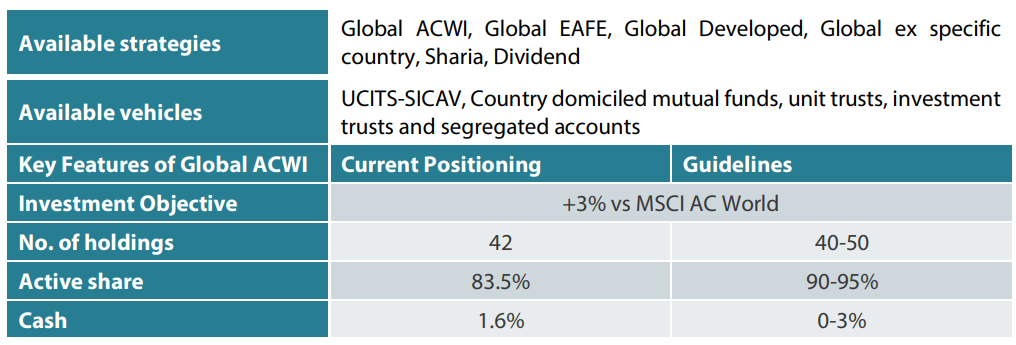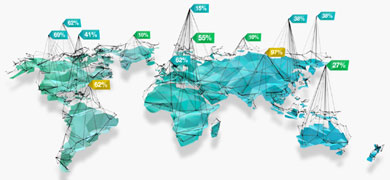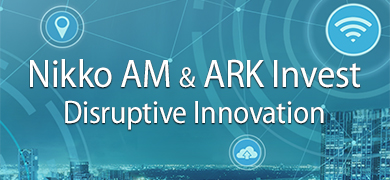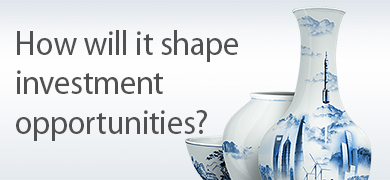Global equity investment philosophy
Our philosophy is centred on the search for “Future Quality” in a company. Future Quality companies are those that we believe will attain and sustain high returns on investment. ESG considerations are integral to Future Quality investing as good companies make for good investment. The four pillars we use to assess the Future Quality characteristics of an investment are:
Franchise
- does the company have a sustainable competitive advantage?
Management
- does the company make sound strategic and capital allocation decisions?
Balance Sheet
- is growth appropriately financed?
Valuation
- are the company’s prospects under-appreciated by the market?
We believe that investing in Future Quality companies will lead to outperformance over the full market cycle. Our strategy is based on fundamental, bottom-up research therefore sector and country allocations are a function of stock selection. The Global Equity strategy is a concentrated, high conviction portfolio with a high active share ratio.
Market Outlook
The West Coast of Scotland harbours a well-known secret: the naval base at Faslane. Located just 80 nautical miles from the historic Isle of Rhum (or Rum), known as the diamond of the Western Isles, Faslane houses the support network for the UK’s nuclear submarine deterrent, a subject that frequently makes headlines in Scotland. Despite the controversy, defence and nuclear capabilities are undergoing a renaissance. For many nations, Donald Trump’s second term as US president has served as a final wake-up call, highlighting their lack of preparedness in national defence. European defence spending is estimated to increase by at least US dollar (USD) 250 billion annually if the continent is to meet its revised target of 3.5% of GDP.
During the quarter, we increased our exposure to aerospace and defence with the purchase of US company TransDigm Group Incorporated—a leading global supplier of highly engineered aircraft components for both commercial and military aerospace markets. A combination of sole-source, proprietary products, high switching costs for clients, and the cost-effectiveness of its components compared to total aircraft cost supports its strong cash flow and return on investment.
According to the Kiel Institute, Europe-wide GDP could be boosted by as much as 0.9% to 1.5% if defence spending rises to 3.5% of GDP. Rising European GDP is one of the reasons we added Italian bank Intesa Sanpaolo S.p.A. to the portfolio.
Intesa is also benefiting from an improved yield curve, high levels of fees and commissions through its successful asset management businesses, and progress in a transformational IT investment—all of which are expected to drive returns higher.
While markets have been volatile, we have consistently followed the Future Quality process, which led us to further de-risk the portfolio with additions in L’Oréal S.A. and Mastercard Incorporated. L’Oréal stands out as a structurally advantaged global leader in the 290 billion euro beauty market, with a clear strategy to “democratise the best of beauty”. The company combines scale with agility—delivering consistent outperformance and expanding at 1.5x the growth rate of the global beauty market—by leveraging a highly diversified portfolio spanning mass market to premium categories.
Mastercard’s strong market position and data capabilities create a flywheel effect, enabling the company to sell value-added services to clients, such as security solutions. The strength of its franchise, stability of returns and underappreciated opportunity in value-added services present a compelling case for investors.
New ideas were funded by divesting from Taiwan Semiconductor Manufacturing Co., Ltd. (TSMC), which we believe is being forced to invest heavily outside Taiwan, thereby increasing pressure on future returns. We also divested from Interactive Brokers Group, Inc., which had performed extremely well since our initial investment, and Hoya Corporation, where our conviction had declined in recent months. Despite Schlumberger Limited (SLB) being a top-tier player in oil services, we decided to sell the company in anticipation of weakening oil prices. Additionally, we continued to take profits in several winners, including Netflix, Inc., Palomar Holdings, Inc. and Cencora, Inc.
The second quarter of 2025 proved just as turbulent as the first. US policy remains a key source of volatility, but after the initial tariff shock, markets largely moved past it. Indeed, despite nearly entering bear market territory in early April, markets ended the quarter at new all-time highs. This raises concerns given the range of risks facing the US in the second half of 2025—PMI and recruitment indicators suggest challenging times ahead. Global growth remains elusive, though more visible progress is being witnessed in large infrastructure spending areas such as AI, defence and electrification. Consumer-driven growth appears limited, while governments continue to deploy increasingly sophisticated methods to deliver and finance their election promises.
The sky isn’t the limit for financial markets, and the stars won’t provide guidance or answers. At Nikko Asset Management, we will keep our feet firmly on the ground, continuing our search for Future Quality ideas, where we believe stock selection will remain the key driver of excess returns.
Global Equity strategy composite performance to June 2025

Past performance is not a guide to future returns. Source: Nikko AM, FactSet.
*The benchmark for this composite is MSCI ACWI Net Total Return Index. The benchmark was the MSCI ACWI ex AU since inception of the composite to 31 March 2016. Inception date for the composite is 01 October 2014. Returns are based on Nikko AM’s (hereafter referred to as the “Firm”) Global Equity Strategy Composite returns. Gross returns are presented gross of management fees, performance fees, custodial fees and withholding tax but net of all trading commissions. Returns for periods in excess of 1 year are annualised. Any comparison to a reference index or benchmark may have material inherent limitations and therefore should not be relied upon.
Data as of 30 June 2025.
Nikko AM Global Equity: Capability profile and available vehicles (as at June 2025)

Target return is an expected level of return based on certain assumptions and/or simulations taking into account the strategy’s risk components. There can be no assurance that any stated investment objective, including target return, will be achieved and therefore should not be relied upon. Any comparison to a reference index or benchmark may have material inherent limitations and therefore should not be relied upon.
Past performance is not indicative of future performance. Nikko AM Representative Global Equity account. Source: Nikko AM, FactSet.
Nikko AM Global Equity Team

This Edinburgh based team provides solutions for clients seeking global exposure. Their unique approach, a combination of Experience, Future Quality and Execution, means they are continually “joining the dots” across geographies, sectors and companies, to find the opportunities that others simply don’t see.
There are four key areas that make our strategy different:
– a focus on Future Quality companies – a different and clear philosophy
– a distinctive team culture – a tight-knit team with a process built on openness and respect
– unique execution, including rigorous team challenge of every idea
– differentiated portfolios, with a strong track record in stock-picking and ESG integration
Future Quality companies
We believe that companies with superior long-term returns on investment will deliver better performance. We call these Future Quality companies, and it is only these companies that make it into client portfolios. We search for Future Quality through analysis and financial modelling of companies that we expect to deliver over the next five years, and beyond. This approach is supported by academic evidence that businesses with high and improving returns on invested capital provide superior compound performance over the long term. With this investment time horizon, the sustainability of returns is a crucial ingredient of our Future Quality approach. We have found that companies developing solutions to ESG issues and management teams providing value to all stakeholders are more likely to be successful at sustaining high returns on invested capital over the long-term.
Distinctive team structure and culture
We believe that our collective knowledge and experience are powerful tools for delivering investment performance. Since 2011, we have operated a team-based approach to uncovering Future Quality investment ideas and have fostered a strong group dynamic. Individually, each Portfolio Manager is an expert investor with a broad skillset and experience of many market cycles.
We work in a flat structure, where all our Portfolio Managers have a dual role that combines investment analysis and investment management responsibilities. With individual analytical coverage split along industry lines, each Portfolio Manager is a specialist in the stocks and sectors they cover.
We all actively challenge the ideas and analysis of colleagues throughout the investment process, in an open atmosphere of vigorous and constructive debate. Portfolio Analysts work alongside Portfolio Managers, typically researching thematic trends that could influence and uncover future investment opportunities.
We take collective responsibility for approving stocks for the portfolio, and therefore there is joint accountability for performance. As such, it is in everyone’s interest to ensure that the investment analysis is thorough and that no stone is left unturned in the search for Future Quality.
We believe that the broad experience of our Portfolio Managers and distinctive team-based approach that sees everyone contributing to the strategy, increases the probability of successfully uncovering Future Quality.
Unique execution
Our tight-knit team approach and flat structure enable us to execute in a transparent way, including a rigorous team challenge of every idea. By using our strict Future Quality standards, we can identify long-term winners from the broader universe, to narrow down a comprehensive watch list and around 100 deep dive researched ideas. This is within a unique framework of individual accountability for the underlying analysis and company research, combined with the collective challenging of assumptions at the team level. Our proprietary ranking tool creates a disciplined process to compare and rank attractive opportunities and ensures that at the portfolio construction phase, only our best-ranked ideas receive the most committed weights in client portfolios. We believe our culture is key, and the collective ownership of our research process brings the best portfolio outcomes for clients.
Differentiated portfolios
We deliver a high-conviction Global Equity strategy for clients that is not constrained by benchmarks. As such, Future Quality can be sourced from listed businesses across any geography or sector. And, in a world awash with investment prospects, our disciplined, accountable and transparent process helps us to focus solely on building portfolios from companies that best meet our specific Future Quality criteria.
In terms of balancing risk and reward, our track record shows that we consistently deliver attractive returns on a lower risk-adjusted basis compared with peers and the global reference benchmark. The high active share and concentrated number of holdings help ensure that our Future Quality stock-selection process delivers differentiated portfolios.
Risks
Emerging markets risk - the risk arising from political and institutional factors which make investments in emerging markets less liquid and subject to potential difficulties in dealing, settlement, accounting and custody.
Currency risk - this exists when the strategy invests in assets denominated in a different currency. A devaluation of the asset's currency relative to the currency of the strategy will lead to a reduction in the value of the strategy.
Operational risk - due to issues such as natural disasters, technical problems and fraud.
Liquidity risk - investments that could have a lower level of liquidity due to (extreme) market conditions or issuer-specific factors and or large redemptions of shareholders. Liquidity risk is the risk that a position in the portfolio cannot be sold, liquidated or closed at limited cost in an adequately short time frame as required to meet liabilities of the Strategy.






